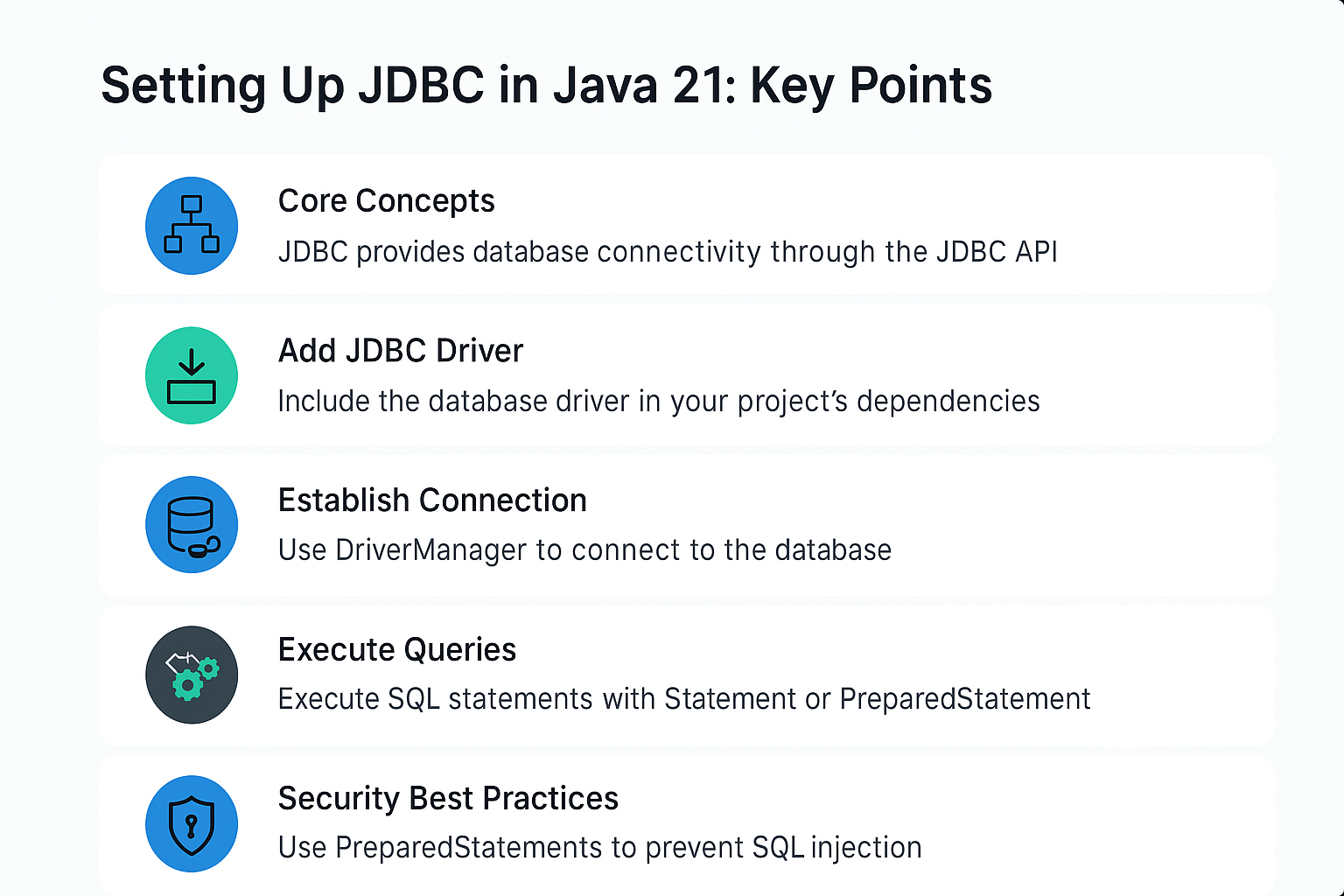Introduction
Setting up JDBC (Java Database Connectivity) in Java 21 is the first step towards building robust, database-driven applications. JDBC acts as a standard API that allows Java applications to interact with relational databases such as MySQL, PostgreSQL, Oracle, and SQL Server.
Why JDBC Setup Matters
- Foundation for Data-Driven Apps: JDBC provides the gateway to storing and retrieving data in Java applications.
- Supports Multiple Databases: Write once, connect to any RDBMS with the right driver.
- Essential for Enterprise Applications: Used in web servers, microservices, and standalone apps.
Core Concepts of JDBC Setup
JDBC Architecture
Java Application → JDBC API → DriverManager → JDBC Driver → Database
- DriverManager: Handles database drivers and connections.
- Connection: Represents a session with the database.
- Statement / PreparedStatement: Executes SQL queries.
- ResultSet: Holds query results.
Real-World Use Cases
- Web Backends: E-commerce platforms and REST APIs.
- Desktop Applications: Inventory or accounting systems.
- Data Migration Tools: ETL processes connecting multiple databases.
Step-by-Step Guide: Setting Up JDBC in Java 21
1. Add JDBC Driver Dependency
MySQL (Maven):
<dependency>
<groupId>mysql</groupId>
<artifactId>mysql-connector-java</artifactId>
<version>8.0.33</version>
</dependency>
PostgreSQL (Maven):
<dependency>
<groupId>org.postgresql</groupId>
<artifactId>postgresql</artifactId>
<version>42.6.0</version>
</dependency>
2. Establish a Connection
import java.sql.*;
public class JDBCSetup {
public static void main(String[] args) {
String url = "jdbc:mysql://localhost:3306/testdb";
String user = "root";
String password = "password";
try (Connection conn = DriverManager.getConnection(url, user, password)) {
System.out.println("Connected to database successfully!");
} catch (SQLException e) {
e.printStackTrace();
}
}
}
3. Execute SQL Queries
String sql = "SELECT id, name FROM employees";
try (Statement stmt = conn.createStatement();
ResultSet rs = stmt.executeQuery(sql)) {
while (rs.next()) {
System.out.println(rs.getInt("id") + " - " + rs.getString("name"));
}
}
Statement vs PreparedStatement
| Feature | Statement | PreparedStatement |
|---|---|---|
| SQL Injection Safety | Vulnerable | Safe via parameter binding |
| Performance | Re-parsed every execution | Precompiled, efficient for reuse |
| Parameters | Hardcoded in query | Uses ? placeholders |
PreparedStatement Example
String sql = "INSERT INTO employees (name, role) VALUES (?, ?)";
try (PreparedStatement ps = conn.prepareStatement(sql)) {
ps.setString(1, "Alice");
ps.setString(2, "Manager");
ps.executeUpdate();
}
Common Mistakes and Anti-Patterns
- Not using try-with-resources, leading to connection leaks.
- Hardcoding database credentials.
- Ignoring PreparedStatements, making apps vulnerable to SQL injection.
- Creating a new connection for every query instead of using a pool.
Security Implications
- SQL Injection Protection: Always use
PreparedStatement. - Credential Management: Store credentials securely (env variables, secrets manager).
- Encrypted Connections: Use SSL/TLS for production databases.
Performance and Scalability
- Connection Pooling: Use HikariCP or Apache DBCP for efficient connection reuse.
- Batch Operations: Combine multiple inserts/updates for speed.
- Indexing: Optimize database schema for frequent queries.
Batch Example
String sql = "INSERT INTO logs (message) VALUES (?)";
try (PreparedStatement ps = conn.prepareStatement(sql)) {
for (int i = 0; i < 500; i++) {
ps.setString(1, "Log entry " + i);
ps.addBatch();
}
ps.executeBatch();
}
Best Practices
- Always close resources using try-with-resources.
- Use connection pooling in production environments.
- Separate SQL queries from Java business logic.
- Test connections on startup to catch misconfigurations early.
Real-World Analogy
Think of JDBC setup like setting up a bridge between a city and a warehouse. The Java app is the city, the database is the warehouse, and JDBC is the bridge that allows smooth transportation of goods (data).
Conclusion & Key Takeaways
- JDBC setup is the foundation for Java-database interaction.
- Use secure and optimized practices (PreparedStatements, pooling).
- Java 21 makes JDBC integration seamless with modern features.
FAQ
-
What is JDBC setup in Java?
It’s the process of configuring Java to connect and interact with a relational database. -
Which databases are supported in JDBC Java 21?
MySQL, PostgreSQL, Oracle, SQL Server, and more. -
Do I need a JDBC driver for every database?
Yes, each database vendor provides a specific JDBC driver. -
Is JDBC the same in Java 21 as older versions?
Yes, with minor improvements; the API remains backward-compatible. -
How to avoid SQL injection in JDBC?
UsePreparedStatementwith parameterized queries. -
What is the best connection pooling library?
HikariCP is widely regarded as the fastest and most efficient. -
Can I use JDBC in a Spring Boot app?
Yes, Spring Boot builds on JDBC and simplifies configuration. -
How to handle transactions in JDBC?
UsesetAutoCommit(false)and callcommit()orrollback()manually. -
Is it necessary to close JDBC resources?
Absolutely; failing to close them causes memory and connection leaks. -
Which is better: MySQL or PostgreSQL for Java 21 apps?
Both are excellent; PostgreSQL offers advanced features, MySQL is simpler for beginners.
